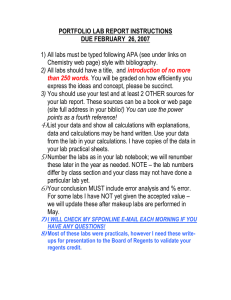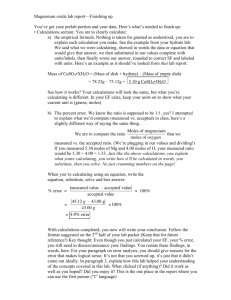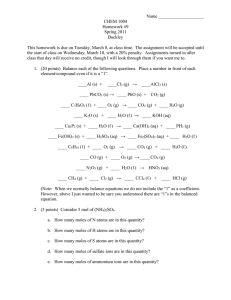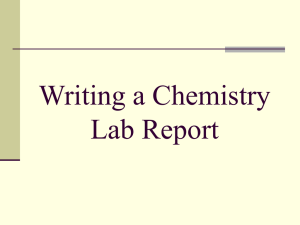PORTFOLIO LAB REPORT INSTRUCTIONS DUE FEBRUARY 26, 2007
advertisement
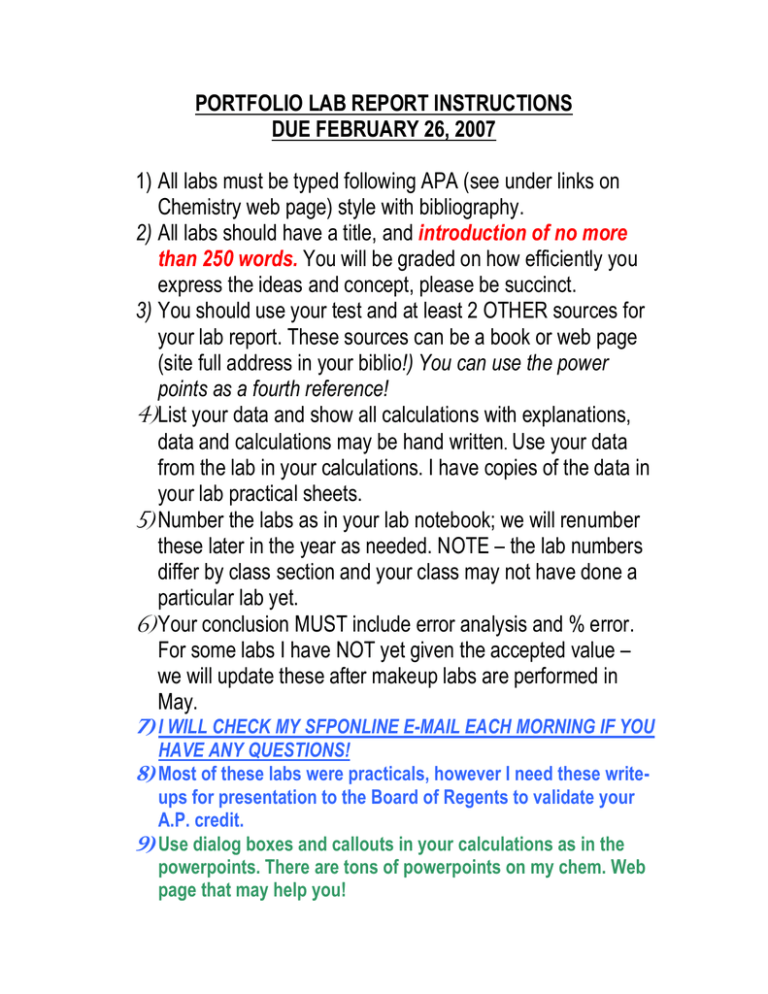
PORTFOLIO LAB REPORT INSTRUCTIONS DUE FEBRUARY 26, 2007 1) All labs must be typed following APA (see under links on Chemistry web page) style with bibliography. 2) All labs should have a title, and introduction of no more than 250 words. You will be graded on how efficiently you express the ideas and concept, please be succinct. 3) You should use your test and at least 2 OTHER sources for your lab report. These sources can be a book or web page (site full address in your biblio!) You can use the power points as a fourth reference! 4) List your data and show all calculations with explanations, data and calculations may be hand written. Use your data from the lab in your calculations. I have copies of the data in your lab practical sheets. 5) Number the labs as in your lab notebook; we will renumber these later in the year as needed. NOTE – the lab numbers differ by class section and your class may not have done a particular lab yet. 6) Your conclusion MUST include error analysis and % error. For some labs I have NOT yet given the accepted value – we will update these after makeup labs are performed in May. 7) I WILL CHECK MY SFPONLINE E-MAIL EACH MORNING IF YOU HAVE ANY QUESTIONS! 8) Most of these labs were practicals, however I need these writeups for presentation to the Board of Regents to validate your A.P. credit. 9) Use dialog boxes and callouts in your calculations as in the powerpoints. There are tons of powerpoints on my chem. Web page that may help you! WATER OF HYDRATION OF Cu(SO4). X H2O 1) OBJECTIVE to find the integer mole ratio (X) between H2O and Cu(SO)4. 2) Use file #6 on my SFP chemistry site as a template, you can copy the drawings and modify them. I did not give this to you yet because you designed this procedure in the lab! 3) Present your data. 4) Present all masses and your calculation of the mass of water driven off, and your moles of H2O and Cu(SO4). Show your ratio and compare the accepted value of X = 5 in Cu(SO)4. 5 H2O. 5) LAB REVIEW QUESTIONS (THE LAST SECTION AFTER BIBLIOGRAPHY). a. For the compound Cu(SO4). 5 H2O, calculate the % composition of each element in a chart. i. How many moles of each element are in this compound. ii. What is the % composition of water in the above. b. For the substances: Fe(NO3)2 . 4 H2O, Fe(NO3)2 . 3 H2O, Fe(NO3)2 . 2 H2O, design an experiment to analyze a sample that could be any one of these and identify which one. Give sample data or percentages. SCORING: TASK – EXPLAIN HYDRATES AND DETERMINATION OF WATER OF HYDRATION CALCULATION. Level 1, basic definitions and calculations Level 2, definitions explain the theories and calculations completely 6 8 Level 3, theories explain results and are integrated with calculations and error analysis part of conclusion. 10 CALCULATION OF THE MASS OF A SAMPLE OF Mg(S) METAL BY DETEMINATION OF H2 GAS BY WATER DISPLACEMENT. 1) Objective, MEASURE THE H2 IN THE EUDIOMETER AND CONVERT IT TO MOLES (PV=nRT), RATIO TO Mg MOLES AND CONVERT Mg TO GRAMS. 2) EQUATIONS YOU NEED. TEMP. IN KELVINS PRESSURE. IN ATM PV = nRT VOL IN LITERS The constant R units are L ATM Mol K NUMBER OF MOLES YOU ALREADY DID THIS LAB PRACTICAL, THEREFORE IT IS HONORABLE TO COPY THESE DRAWINGS TO MAKE YOUR REPORT BETTER. MOLES = MASS MOLAR MASS 3) Calculate the moles of hydrogen from the volume of the bubble in the eudiometer, use the first equation. Ratio moles hydrogen to moles Mg in the reaction: 2 HCl(aq) + Mg(s) MgCl2 + H2 4) In your intro, discuss the ideal gas equation, compare real to ideal gasses, and discuss Avogadro’s law. You should also discuss that fact that equal volumes of ANY have the same number of moles in the PV=nRT equation. Answer, can any gas be collected by water displacement, discuss water displacement and the how a eudiometer works. SCORING: TASK – Mg(s) mole ratio to H2(g) : Eudiometer Level 1, basic definitions and calculations Level 2, definitions explain the theories and calculations completely 6 8 Level 3, theories explain results and are integrated with calculations and error analysis part of conclusion. 10 COOLING AND HEATING CURVES 1) Explain all of the parts of BOTH a heating and cooling curve in your intro, HAND draw the curves. Discuss all energy and phase change parameters. The substance was BHT (mp = 73o) or LAURIC ACID (mp = 44oC) depending on your class section. 2) In results plot YOUR DATA for both curves. Indicate the melting/freezing point plateau and HOW YOU IDENTIFY THE PLATEAU WHEN YOU ONLY SEE ONE OF THE TWO, how do you know if it is the melting or boiling point. 3) Calculate the ∆Tf of the mixture of both. Plot the freezing pint depression curve. SCORING TASK: discuss cooling curves and your cooling and heating curve data. Level 1:Basic definitions and heating curves Level 2:Explain and label curves, ∆Tf , q equations explained Level 3: Explain above with concept maps and or outline and or drawings of particles. 6 8 10 DETERMINATION OF MOLECULAR MASS BY VAPOR DENSITY 1) Discuss the concept that equal volumes of gasses have equal moles.(100 words) 2) Do a very extensive experimental design and interpretation.(150 words) 3) Calculate the molar mass. 4) Show your % error. SYNTHESIS AND ANALYSIS OF A COORDINATION COMPLEX OF IRON AND OXALATE. 1) Discuss the experimental design in your intro. Include a very concise discussion of coordination complexes. 2) Data, predict your yield assuming we got about 95% yield. Show all color observations. 3) In your conclusion, explain the absorption scan and its result.
